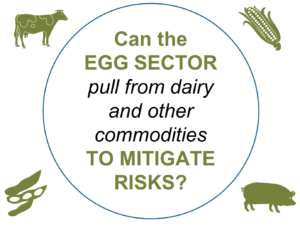Supply chain integration and scaled production have afforded the U.S. egg industry many efficiencies. When everything works as designed, the industry runs smoothly, anticipating and addressing known threats and supplying market demands consistently with little to no disruption. However, the impacts of COVID-19 on the egg industry have been nothing less than catastrophic to many players within the system.
To understand the impacts on the industry, you must first understand the industry as it functions today. We mapped out the two different production systems, shell egg and egg products, in the first article in this series. You can find that here. As things played out in mid-March, these sectors found themselves in verydifferent, yet stressful situations:
Shell Eggs
Shelter-in-place guidance caused a skyrocket for demand in retail locations with unavoidable shortages driving temporary price increases as retailers competed for the precious commodity. Today, prices are back to similar levels seen before COVID-19’s shift in consumer spending.
Egg Products
Many in the egg product market serve only foodservice customers. A blessing when the major restaurant chains, schools and institutional cafeterias are running normally, a hindrance when their customers took a significant hit as consumers, students and office workers sheltered at home. The demand slump caused prices for the liquid egg to plummet, dropping roughly 80 percent in a matter of days. While the price has rebounded slightly as some states and regions begin slowly reopening, the future remains very much up in the air.
These situations led to some serious implications for the egg industry. Egg producers leaned on the Food and Drug Administration to grant temporary changes to protocols required to sell into the shell egg market, hoping to alleviate the shortages on one end of the supply chain and the over-production on the other.
FDA granted these waivers on April 6, 2020, with some restrictions. While appreciated, the delay in the decision caused significant economic, social and environmental implications.
Because eggs are a relatively small market, they do not see futures traded on platforms like other raw materials. Rather, they rely on independent market reporting through Urner-Barry, an industry-leading market specialist in egg, meat, seafood and other related food industry segments.
As the dust settled in March and April, shell egg market producers found themselves as the target of price-gouging accusations and lawsuits from several state attorney generals. Liquid egg producers began seeing the impacts, which ultimately have only just begun. They’ve seen contracts ended through force majeure, causing them to dump inventory into landfills, and halt production through either molting or pre-mature euthanasia and depopulation of millions of hens.
For those in production, this left many asking for changes and flexibility in the system. Could this have been avoided? Possibly. Are there things that can be done to prevent it from happening again in the future? Quite likely.
Like with any challenge, there are often insights industries can pull from other’s experiences. The egg industry doesn’t need to look hard to find these insights within their history and other adjacent agriculture sectors.
National Poultry Improvement Plan
First, we must look at the National Poultry Improvement Program (NPIP), which dates back to the Great Depression. The voluntary program has set a precedence in public/private programs for the poultry industry and has helped curb threats to the industry in the past, including expanding to assist in managing more recent disease outbreaks. With an elevated need for innovation due to COVID-19, could the NPIP once again evolve and continue bringing the industry together with state and national regulators to find common ground? Could such innovations have an opportunity to improve resiliency in the poultry industry and further food security in the United States?
Federal Crop Insurance Program
As we talk about food security, another area to garner insights from is the Federal Crop Insurance Program. A public-private partnership that allows each private, authorized company control in writing and reinsuring policies, marketing the products, adjusting and processing claims, training, and record-keeping. The program is a means to keep crop insurance affordable to producers, providing the efficiencies of the private industry and the regulatory and financial support of the federal government. The program certainly has evolved over the years, including additions like the Dairy Revenue Protection program in 2019. In this example, dairy producers are protected against unexpected declines in the quarterly revenue for milk sales. Could the egg sector benefit from a public/private insurance program that provides risk mitigation and disaster relief?
Risk Mitigation
 Risk mitigation can also come in the form of financial decision-making. For many in agriculture and raw material sectors, price transparency from the futures market provides an expectation-setting experience for everyone involved. The producers rely on the futures market to make production decisions, end-use customers rely on it to make purchasing decisions. Could market transparency lead to more informed decision making across the entire supply chain? Could it assist all parties including consumers in the long-term?
Risk mitigation can also come in the form of financial decision-making. For many in agriculture and raw material sectors, price transparency from the futures market provides an expectation-setting experience for everyone involved. The producers rely on the futures market to make production decisions, end-use customers rely on it to make purchasing decisions. Could market transparency lead to more informed decision making across the entire supply chain? Could it assist all parties including consumers in the long-term?
There are certainly more avenues to explore and questions to answer in a post-COVID-19 egg sector. What does the new industry look like? How do we protect against major disruptions in the value chain again? If the flexibility to meet consumer demand for a safe, wholesome, nutritious product is the ultimate goal, how do we get there in a way that makes economic, social and environmental sense?
Throughout this series The Context Network will continue to dive deeper into perspectives found on these issues throughout the supply chain[1]. As we build the story, we continue to identify additional needs from the industry as a whole. If you’re interested in working with Context to work through those issues, please contact me at matt.sv@contextnet.com
[1]United Egg Producers, Egg Industry Center and Oskaloosa Foods contributed to this series.


